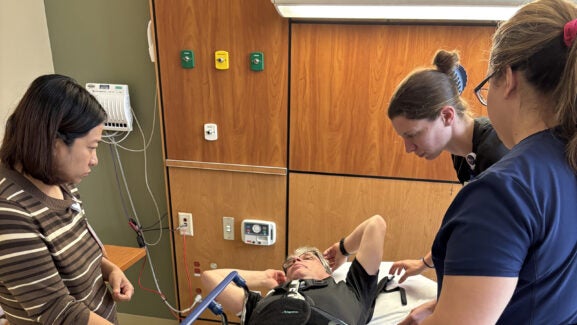

Tool for Protecting Soldiers’ Brain Health Earns $3.2 Million Grant
A team led by UVA School of Medicine researcher and UVA Health radiologist James Stone, MD, PhD, has received $3.2 million from the U.S. Department of Defense to enhance a critical tool for protecting the brain health of military personnel.
The project aims to upgrade the Generalized Blast Exposure Value (GBEV) tool that assigns a numerical score to a service member’s history of blast exposures that can be used to assess the potential for adverse health outcomes.
“This will represent a major step forward in how the military monitors, protects, and cares for its service members,” says Dr. Stone. “This kind of translational research has the potential to directly inform policy, improve training safety, and guide individualized medical decisions for those who serve.”
Understanding Blast Exposures
The project builds on close to two decades of research by Stone and his collaborators that seeks to better understand how repeated exposure to blasts — common in military training and combat — affects the brain over time.
Regular, low-level, blast exposures from weapons or breaching, where explosives are used to enter buildings or other structures, can cause cumulative brain injuries and subtle but meaningful changes in brain function. To measure the impact of these blast exposures, Stone has been working with Capt. Stephen Ahlers (retired), PhD, Naval Medical Research Command, to utilize the Blast Exposure Threshold Survey (BETS) and GBEV to link neurological changes to career blast exposures in service members and veterans.
“I’ve had the privilege of working with Dr. Ahlers for more than 18 years, and our collaboration has led to many key contributions in the field of repeated low-level blast exposure. His deep expertise in military brain health research and unwavering commitment to service member health have been instrumental in developing tools like the GBEV,” Dr. Stone says. “This continued partnership forms an important foundation for advancing our shared goal of protecting brain health in military populations.”
About the Project
Their latest project will bring together data from more than 16,000 service member assessments across 10 previous research studies, spanning diverse military groups, to refine and strengthen the GBEV tool. The aim is to give the Department of Defense a more precise, data-driven way to identify at-risk individuals, guide protective measures and drive the care that members of the military receive.
“We are also incorporating key members of the Department of Defense public health community — including representatives from the services and the Defense Health Agency — into this effort,” Ahlers says. “By integrating these components, we aim to enhance support for the warfighter, operational units, Department of Defense public health entities and both Department of Defense and Department of Veterans Affairs health providers working to monitor and mitigate the effects of blast exposure on warfighter and veteran health and performance.”
The project’s collaborators include Naval Medical Research Command, Defense Health Agency’s TBI Center of Excellence, Uniformed Services University of the Health Sciences, Henry M. Jackson Foundation, and the University of Utah.
Latest News




Congrats!